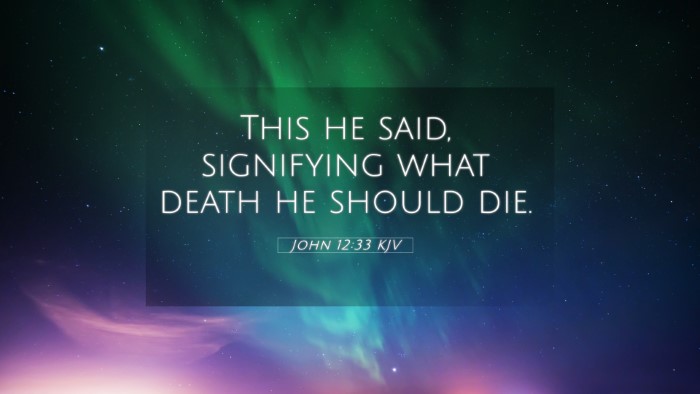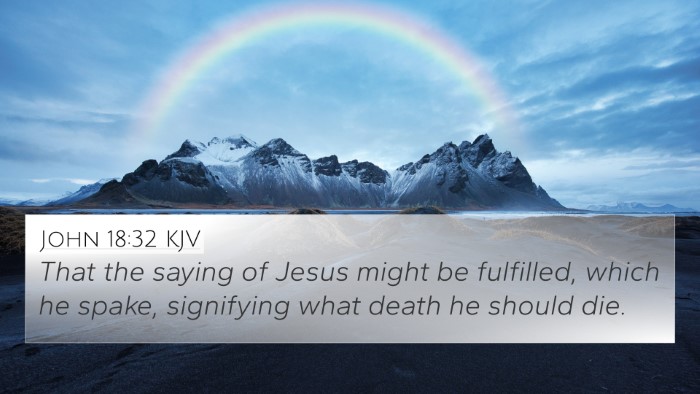Understanding John 12:33
In John 12:33, the verse states:
"This he said, signifying what death he should die."
This verse carries deep theological significance and rich contextual meanings that illuminate the nature of Christ's mission and the method of His sacrifice. Below, we explore insights drawn from renowned public domain commentaries, offering a comprehensive understanding of the verse.
Context and Analysis
As part of the Gospel narrative, John 12:33 occurs at a pivotal moment where Jesus is preparing for His impending crucifixion. The verse indicates that He is alluding to His death, a central theme in Christian theology that showcases the meaning behind the cross.
Insights from Commentaries
-
Matthew Henry's Commentary:
Henry emphasizes that Jesus predicted His crucifixion with a clear understanding of what it entailed. His death is not merely a tragic end but the culmination of divine purpose, foreseen by Christ Himself and necessary for the redemption of humanity.
-
Albert Barnes' Notes:
Barnes points out that this phrase signifies that Jesus was aware of the manner of His death, illustrating His total submission to the will of the Father. It serves as a prophetic mark of the sacrificial nature of His mission, intertwining His glory with His suffering.
-
Adam Clarke's Commentary:
Clarke indicates that the reference to His death carries an implication of the greater picture of atonement. Jesus did not die randomly; His death was part of a foreordained plan, and this awareness strengthens the believer's understanding of the events surrounding the crucifixion.
Biblical Cross-References
This verse is interconnected with several other scriptures that enhance its meaning:
- Isaiah 53:5 - "But he was wounded for our transgressions, he was bruised for our iniquities..."
- Matthew 20:18-19 - "Behold, we go up to Jerusalem; and the Son of man shall be betrayed unto the chief priests..."
- Mark 10:33-34 - "Saying, Behold, we go up to Jerusalem; and the Son of man shall be delivered unto the chief priests..."
- Luke 9:22 - "Saying, The Son of man must suffer many things, and be rejected of the elders..."
- Philippians 2:8 - "And being found in fashion as a man, he humbled himself, and became obedient unto death..."
- Hebrews 12:2 - "Looking unto Jesus the author and finisher of our faith; who for the joy that was set before him endured the cross..."
- 1 Peter 1:19 - "But with the precious blood of Christ, as of a lamb without blemish and without spot..."
Thematic Connections
John 12:33 serves as a vital link within the larger narrative of the Gospel, revealing key themes such as:
-
The Sacrificial System:
The allusion to death ties into the overarching concept of sacrifice presented throughout Scripture. The connection reflects God's desire for redemption.
-
Suffering and Glory:
The duality of Christ's suffering leading to glory encapsulates the paradox of the Christian faith, where the crucifixion leads to resurrection.
-
Divine Foreknowledge:
Jesus’s mention of His death reflects the notion that God’s plan was intentional and preordained, leading to redemption.
Cultural and Historical Context
Understanding the context of Jesus’s statement also illuminates the cultural tensions of His time. The Jewish expectation of a Messiah conflicted with the reality of a suffering servant:
-
Jewish Expectations:
The Jews sought a political savior, and Jesus's assertion of a sacrificial death challenged their preconceived notions.
-
Roman Influence:
Understanding Roman execution methods highlights the brutality of crucifixion and the significance of Jesus' death within that framework.
Application for Believers
For modern Christians, John 12:33 serves as a reminder of the cost of discipleship. The themes of sacrifice and purpose encourage believers to reflect on their own lives:
- Embracing the Cross: Jesus calls His followers to take up their cross, which involves self-denial and an acceptance of persecution for faith.
- Living in Light of Redemption: Understanding the significance of Jesus’ death prompts a response of gratitude, leading to a transformative faith.
- Proclaiming the Gospel: This verse encourages Christians to share the message of salvation, emphasizing that God's plan was fulfilled through Christ’s redemptive work.
Conclusion
The depth of understanding found in John 12:33 unveils a profound truth about Jesus Christ's mission on Earth. By linking this verse to broader biblical themes and cross-references, believers gain insight into the sacrificial nature of Christ's love. The cross stands not only as a symbol of suffering but also as a beacon of hope and redemption, shaping the Christian experience.
The exploration of Jesus’ foretelling of His death in John 12:33 reveals intricacies that can guide believers in their faith journey and enhance their understanding of scriptural connections across the entirety of the Bible.
Further Study and Tools
For those interested in delving deeper into the connections between Bible verses and enhancing their scriptural studies, the following tools and resources can be helpful:
- Bible Concordance: An essential tool for identifying key terms and related verses.
- Cross-Reference Bible Study: A method for exploring thematic connections.
- Bible Reference Resources: Reference materials that aid in understanding and interpreting scriptures.
- Bible Chain References: Systems that guide readers through interconnected Scriptures.
- Comprehensive Bible Cross-Reference Materials: Detailed resources that provide insight into scriptural interconnections.




